Intel 第四代至强处理器 Sapphire Rapids (SPR) 支持
- 支持包括 enqcmd(s)、AMX 系列指令等。
- 支持 DSA (Data Streaming Accelerator)、IAA (Intel Analytic Accelerator)、QAT (QuickAssist Technology,OOT 支持)、DLB (Dynamic Load Balancer,OOT 支持)加速器。
- 支持 SIOV (Scalable IO virtualization)。
其中 Intel® DSA 是集成到英特尔® 处理器(从第四代英特尔® 至强® 处理器开始)的高性能数据复制和转换加速器,它的目标是优化高性能存储、网络、持久内存和各种数据处理应用程序中常见的流数据移动和转换操作。
本文笔者将对 Intel® DSA 的配置和测试作简要介绍和分析。
DSA 配置
笔者的测试环境如下:
- CPU:Intel(R) Xeon(R) Platinum 8475B
- RAM:DDR5 32GB x 16
- Kernel:Vanilla Kernel 6.4.16
- OS:Alibaba Cloud Linux 3
- Sockets:2
硬件与内核要求
硬件要求
首先你的 CPU 需要有 DSA 加速器,需要是 Intel 第四、五代至强 SPR 处理器系列。关于 Intel 第四、五代至强处理器的相关比较信息,请查看下面两个链接以及 Intel@ Built-In Accelerators:
查看当前设备的 DSA 硬件,确认处理器以及集成 DSA 硬件:
ls -df /sys/bus/dsa/devices/dsa*

启用 DSA 需要两个条件:
- 在 BIOS 中启用 Virtualization technology for directed I/O (VT-d) 。
- Linux kernel version version 要大于等于 5.10。(另一种说法是 5.18,如果需要启用 SWQ)
排查 VT-d 是否启用的办法:
dmesg -t | grep ACPI | grep DMAR
如果启用了的话,可以看到类似输出,

内核要求
建议使用 >= 5.18 版本的内核。
在内核编译选项中启用 IOMMU 和 DSA 驱动:
CONFIG_INTEL_IOMMU=y
CONFIG_INTEL_IOMMU_SVM=y
CONFIG_INTEL_IOMMU_DEFAULT_ON=y
CONFIG_INTEL_IOMMU_SCALABLE_MODE_DEFAULT_ON=y
CONFIG_INTEL_IDXD=m
CONFIG_INTEL_IDXD_SVM=y
CONFIG_INTEL_IDXD_PERFMON=y
对于 Vanilla Kernel,一般默认情况下,上面这些选项都已经打开了。CONFIG_INTEL_IOMMU_SCALABLE_MODE_DEFAULT_ON 默认没有设置,也可以不用开启,按照下文添加启动参数也可以解决。
❗❗❗ 打开 5 级页表支持,Processor type and features -> Enable 5-level page tables support,一定要打开。(别问我怎么知道的,官方手册也没有提到过,被这个问题卡了好久)
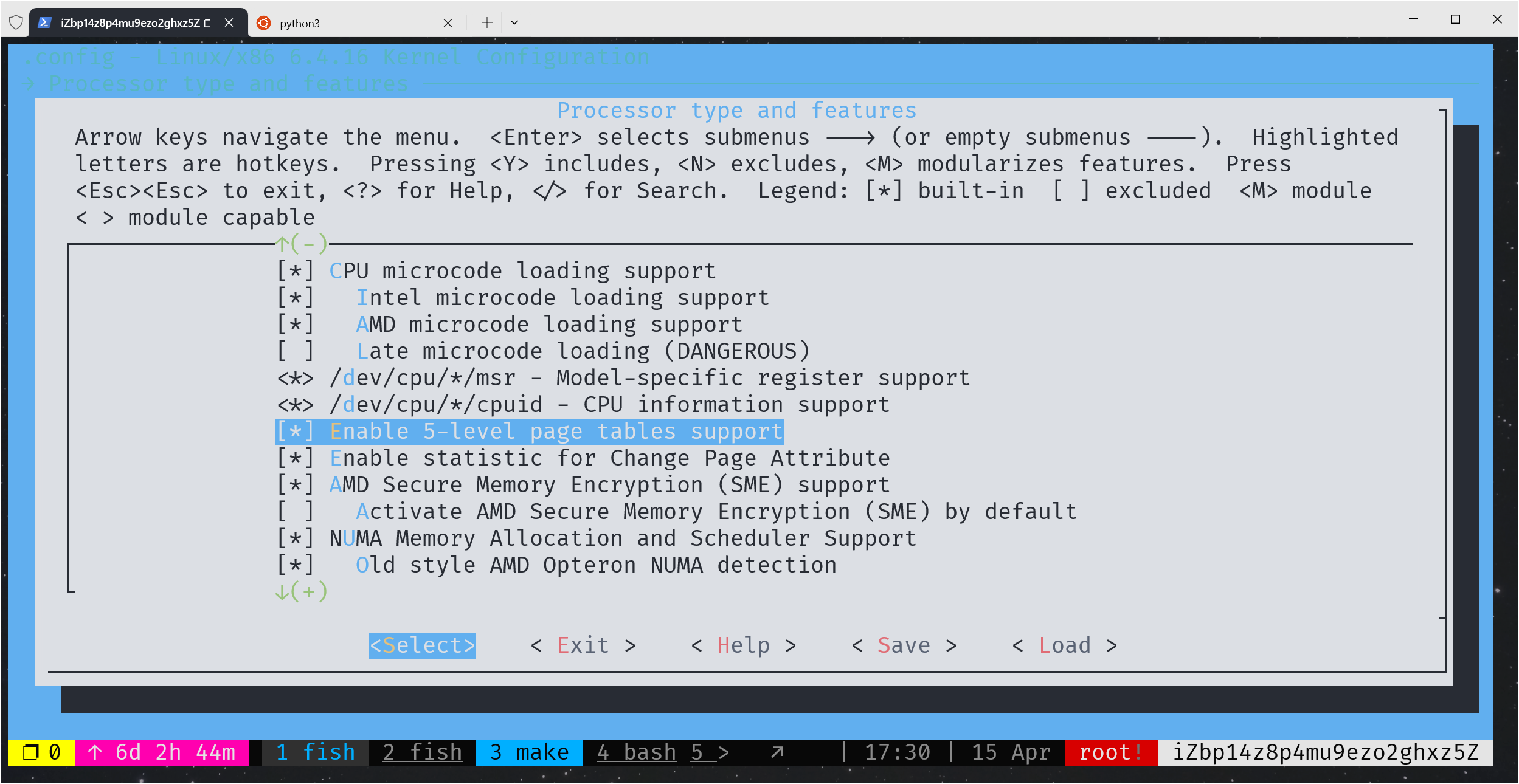
编辑 /etc/default/grub,添加 intel_iommu=on,sm_on。然后更新生成新的启动配置,
sudo grub2-mkconfig -o /boot/efi/EFI/alinux/grub.cfg

用户态配置
需要安装以下组件:
- Accel-config / libaccel-config,DSA 的用户态配置工具
- libnuma,NUMA support for Linux
- Intel® DSA Performance Micros,DSA 性能测试工具,后文将使用它来进行测试
安装 accel-config,开启 test,
git clone https://github.com/intel/idxd-config.git
cd idxd-config
./autogen.sh
./configure CFLAGS='-g -O2' --prefix=/usr --sysconfdir=/etc --libdir=/usr/lib64 --enable-test=yes
make
sudo make install
编译安装后可以通过 accel-config test 来测试。
libnuma 可以通过 yum 安装,如果安装 dsa-perf-micros 找不到库报错,可以尝试编译安装。
安装 dsa_perf_micros,打开调试日志信息,
git clone https://github.com/intel/dsa_perf_micros/
cd dsa_perf_micros
./autogen.sh
./configure CFLAGS='-g -O2 -DENABLE_LOGGING' --prefix=/usr --sysconfdir=/etc --libdir=/usr/lib
启用 DSA
启用 DSA 可以采用命令行手动配置,也可以使用 sh 脚本 / py 脚本,本质上还是配置一个 JSON 格式的 conf。
在 dsa-perf-micros/configs 和 idxd-config/contrib/configs均可以找到配置示例文件。
加载配置文件并启用 DSA:
accel-config load-config -c <config> -e
将当前配置保存到文件,
accel-config save-config -s <config>
查看当前 DSA 配置,
accel-config list
关闭某个 DSA,
accel-config disable-device dsa<DSA_NUM>
根据我的实践,比较好用方便的办法是使用 dsa-perf-micros 提供的 scripts/setup_dsa.sh 配置脚本,可以方便地设置 num wqs,wq id,wq mode,wq size 等,并且在 DSA 已经开启的情况下,能够自动关闭和开启 DSA。
例如配置 Dedicated WQ of max size (128) with 4 engines,
./scripts/setup_dsa.sh -d dsa0 -w 1 -m d -e 4

不过有个缺点,这个 scripts 不支持自定义 max_batch_size。如果需要更自定义的配置,建议直接修改配置文件,并手动启用。例如下面是一份启用 dsa0,1 个 engine,1 个 workqueue,max_batch_size 修改为 64,的完整配置:
[
{
"dev":"dsa0",
"read_buffer_limit":0,
"max_groups":4,
"max_work_queues":8,
"max_engines":4,
"work_queue_size":128,
"numa_node":0,
"op_cap":"00000000,00000000,00000000,00000000,00000000,00000000,00000001,003f03ff",
"gen_cap":"0x40915f0107",
"version":"0x100",
"state":"enabled",
"max_read_buffers":96,
"max_batch_size":1024,
"max_transfer_size":2147483648,
"configurable":1,
"pasid_enabled":1,
"cdev_major":237,
"clients":0,
"groups":[
{
"dev":"group0.0",
"read_buffers_reserved":0,
"use_read_buffer_limit":0,
"read_buffers_allowed":96,
"grouped_workqueues":[
{
"dev":"wq0.0",
"mode":"dedicated",
"size":128,
"group_id":0,
"priority":10,
"block_on_fault":0,
"max_batch_size":64,
"max_transfer_size":2097152,
"cdev_minor":0,
"type":"user",
"name":"app0",
"threshold":0,
"ats_disable":-2,
"state":"enabled",
"clients":0
}
],
"grouped_engines":[
{
"dev":"engine0.0",
"group_id":0
}
]
},
{
"dev":"group0.1",
"read_buffers_reserved":0,
"use_read_buffer_limit":0,
"read_buffers_allowed":96
},
{
"dev":"group0.2",
"read_buffers_reserved":0,
"use_read_buffer_limit":0,
"read_buffers_allowed":96
},
{
"dev":"group0.3",
"read_buffers_reserved":0,
"use_read_buffer_limit":0,
"read_buffers_allowed":96
}
],
"ungrouped_engines":[
{
"dev":"engine0.1"
},
{
"dev":"engine0.2"
},
{
"dev":"engine0.3"
}
]
}
]
常见问题与解决方案
Unable to turn on user SVA feature:
# dmesg | grep idxd
[ 7.927615] idxd 0000:f2:01.0: enabling device (0144 -> 0146)
[ 7.927634] idxd 0000:f2:01.0: Unable to turn on user SVA feature.
[ 7.947937] idxd 0000:f2:01.0: Intel(R) Accelerator Device (v100)
[ 7.947971] idxd 0000:f2:02.0: enabling device (0140 -> 0142)
[ 7.947990] idxd 0000:f2:02.0: Unable to turn on user SVA feature.
[ 7.987380] idxd 0000:f2:02.0: Intel(R) Accelerator Device (v100)
[ 1543.197818] idxd 0000:f2:01.0: Unable to turn on user SVA feature.
[ 1543.202996] idxd 0000:f2:01.0: Intel(R) Accelerator Device (v100)
[ 1543.203158] idxd 0000:f2:02.0: Unable to turn on user SVA feature.
[ 1543.208112] idxd 0000:f2:02.0: Intel(R) Accelerator Device (v100)
相关 Issue:
Unable to turn on user SVA feature when intel_iommu=on,sm_on #46
CPU Information: 4th Gen Intel® Xeon® Scalable Processors
Issue with using Data Streaming Accelerator
Trouble configuring Data Streaming Accelerator (DSA)
Data Streaming Accelerator (DSA) driver idxd reports “Unable to turn on user SVA feature”.
这个问题网上目前没有找到可行的解决方案,很多 issue 都未解决,最后经过无数次尝试,解决办法是需要开启 5 级页表支持(这是我某天在配置 Linux Kernel 开发环境的时候无意间发现的)。DSA 的官方手册中提到“如果 BIOS 不支持 5 级页表,可以在启动参数中加上 no5lvl 以强制开启 4 级页表”,实测没有用。
lspci -vvv -s e7:01.0
正常情况下显示应该如下:
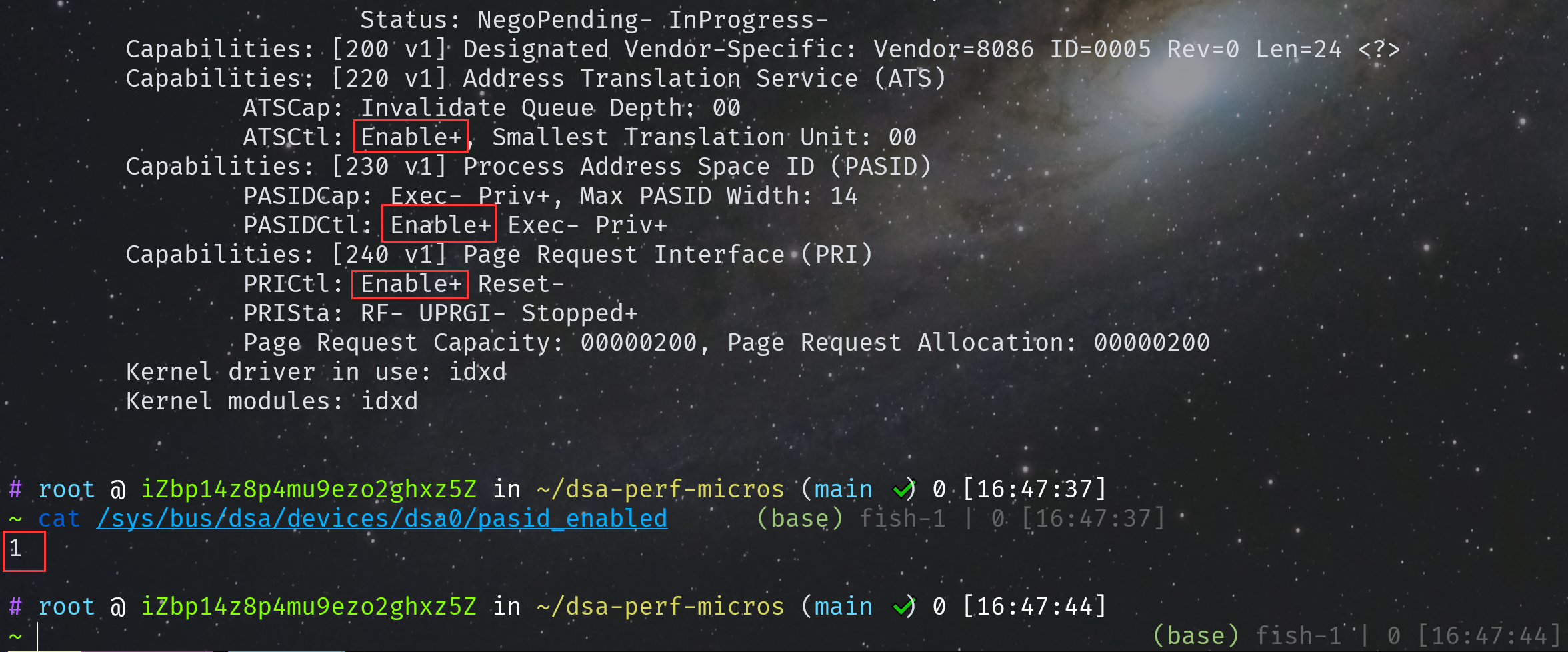
另外,如果在配置 DSA 的时候遇到了类似下面的问题,或者提示 wq size 不合法之类的:
libaccfg: accfg_device_set_read_buffer_limit: dsa0: write failed: Operation not permitted
device set read_buffer_limit value failed
Parse json and set device fail: -1
解决办法是重新加载 idxd 模块,
modprobe -r idxd
modprobe idxd
DSA 介绍
DSA 的架构图如下:

DSA 的基本运行单元是一个 group,可以灵活配置任意数量的 WQ(work queues)和 PE(processing engines)。WQ 又分为两种:
- DWQ(Dedicated WQ):面向单个客户端提交 descriptors。
- SWQ(Shared WQ):可以由多个软件客户端共享,无需线程间同步。
DSA 支持如下操作:
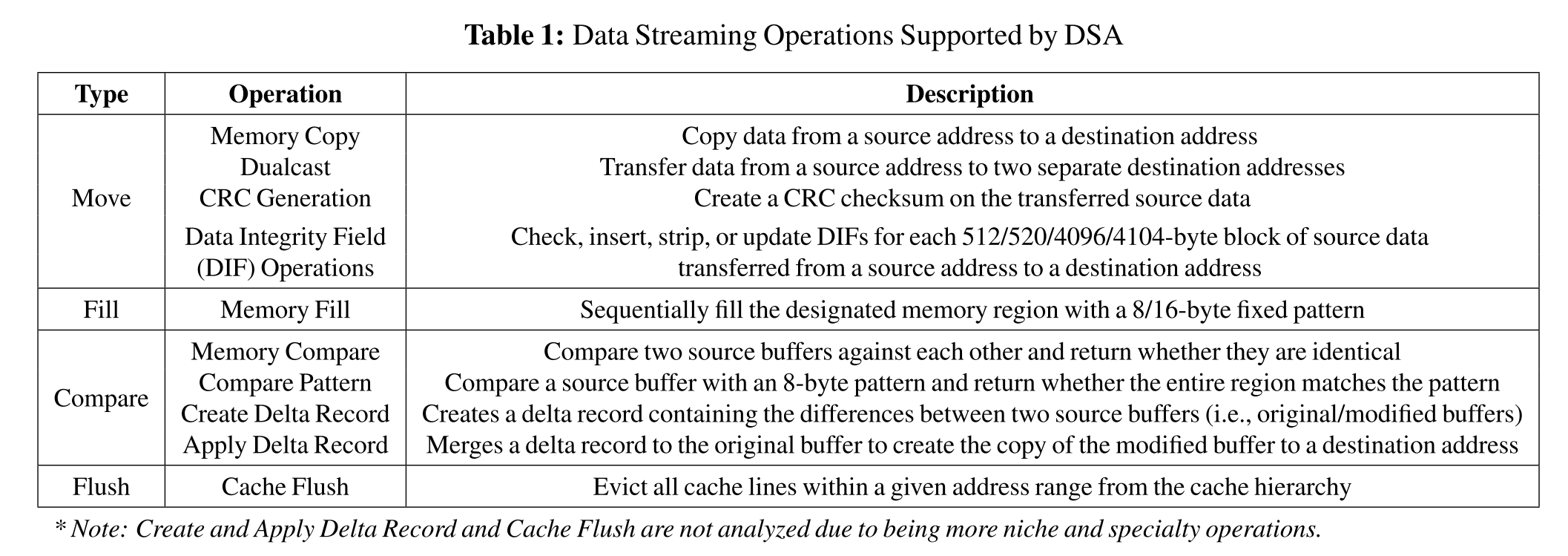
可以在 linux/idxd.h 中找到 DSA 的 opcode,
/* Opcode */
enum dsa_opcode {
DSA_OPCODE_NOOP = 0,
DSA_OPCODE_BATCH,
DSA_OPCODE_DRAIN,
DSA_OPCODE_MEMMOVE,
DSA_OPCODE_MEMFILL,
DSA_OPCODE_COMPARE,
DSA_OPCODE_COMPVAL,
DSA_OPCODE_CR_DELTA,
DSA_OPCODE_AP_DELTA,
DSA_OPCODE_DUALCAST,
DSA_OPCODE_CRCGEN = 0x10,
DSA_OPCODE_COPY_CRC,
DSA_OPCODE_DIF_CHECK,
DSA_OPCODE_DIF_INS,
DSA_OPCODE_DIF_STRP,
DSA_OPCODE_DIF_UPDT,
DSA_OPCODE_CFLUSH = 0x20,
};
DSA 在 Completion Polling 过程有同步(Synchronous offloading)和异步(Asynchronous offloading)两种等待办法。
同步就是通过 while 循环一直等待,直到 comp.status == 0,官方手册的示例代码如下:
retry = 0;
while (comp.status == 0 && retry++ < COMP_RETRY_MAX);
if (comp.status == DSA_COMP_SUCCESS) {
/* Successful completion */
} else {
/* Descriptor failed or timed out
* See the “Error Codes” section of the Intel® DSA Architecture Specification for
* error code descriptions
*/
}
为了减少无用的 CPU 等待时间,把 CPU 资源让度给其它线程,DSA 也支持异步等待,可以通过 pause 指令或者 UMONITOR/UMWAIT 指令实现。pause 实现的官方手册的示例代码如下:
#include <x86gprintrin.h>
retry = 0;
while (comp.status == 0 && retry++ < COMP_RETRY_MAX)
__mm_pause();
UMONITOR/UMWAIT sequence to reduce power consumption while polling,
#include <x86gprintrin.h>
/*
* C0.2 Improves performance of the other SMT thread(s)
* on the same core, and has larger power savings
* but has a longer wakeup time.
*/
#define UMWAIT_STATE_C0_2 0
#define UMWAIT_STATE_C0_1 1
retry = 0;
while (comp.status == 0 && retry++ < MAX_COMP_RETRY) {
_umonitor(&comp);
if (comp.status == 0) {
uint64_t delay = __rdtsc() + UMWAIT_DELAY;
_umwait(UMWAIT_STATE_C0_1, delay);
}
}
DSA 测试
笔者通过 dsa-perf-micros 进行测试。例如测试 Dedicated WQ Bandwidth,
./src/dsa_perf_micros -n128 -s4k -i1000 -c -f -w0 -zF,F -o3
命令参数解释如下:
-n128提交队列深度为 128 ❓(buffer count)-s4k传输大小为 4KB-i10001000 iterations-c通过 SoC 结构获得更高的 movdir64b 指令吞吐量-fSet the cache control flag in descriptors-w0Dedicated Queue-zF,FComma separated list of directives for data placement for respective buffers. The specifiers are -P (fetch into the L1 cache), -D (demote to LLC), -F (flush to memory)-o3操作为 MEMMOVE(DSA_OPCODE_MEMMOVE=3)
如果进行异步测试,那么添加参数 -x 0x000100。查询源码可以确认 misc_flags 的 bit[7:8] => pause(7)/umwait(8) in completion wait。
笔者花了两三天的时间,对照着 A Quantitative Analysis and Guidelines of Data Streaming Accelerator in Modern Intel Xeon Scalable Processors 论文,复现了部分测试结果,完成了 DSA 测试 Shell 脚本编写,以及 Python Matplotlib 绘图脚本编写,一键运行可以完成所有测试,并绘制所有图片。
由于论文中有很多参数其实并没有说清楚,下面的测试中,没有特别说明,均是使用 dsa0-1e1w-d 的配置。Work Queue Size 为 128,buffer count 也是 128,对于 DSA,迭代测试 1000 次;对于 CPU,迭代测试 25 次(因为 CPU 模式的测试速度太慢了)。
Figure 2:Throughput improvements of data streaming operations over their software counterparts with varying transfer sizes (batch size: 1). Memory Fill and NT-Memory Fill refer to allocating and non-allocating writes (similar to regular store and nt-store), respectively.


从图中可以看出,当传输大小 >= 4KB 时,基本就能跑满 PCIE 的带宽。不过有一点比较奇怪的是,我这边没有测出来同步和异步的区别,与论文中的图片数据不太一致。
Figure3:Throughput of DSA’s Memory Copy operation on Sync or Async offloading with varying transfer sizes and batch sizes (BS)
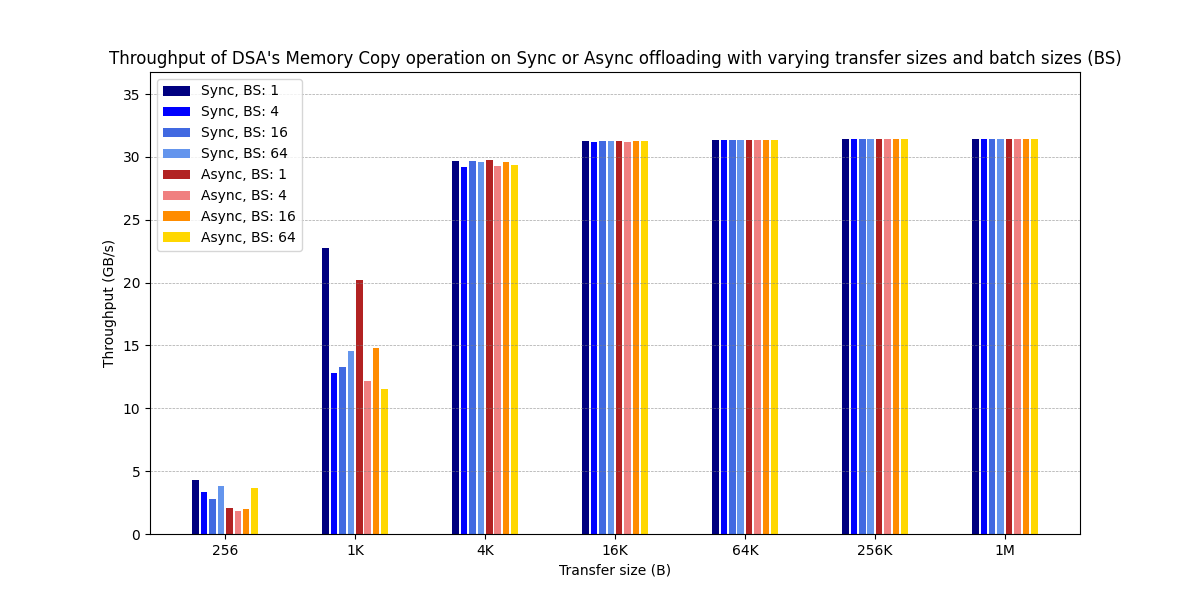
笔者的测试数据要比论文中图片的测试数据表现要好,在 BS = 1 的情况下表现非常好。
Figure 4:Throughput of DSA’s asynchronous Memory Copy operation with different WQ sizes (WQS)

这张图与论文的原图看着最为接近,还是要比论文中图片的测试数据表现要好,尤其是 1K WQS 128 的情况下。BTW,这张图测试的时候 queue size 与 buffer count 保持一致。
Figure 6-a:Throughput (bars) and latency (lines) impact when using different memory configurations (synchronous mode, batch size: 1). Each configuration is labeled as [<Device>: <Source buffer>,<Destination buffer>].
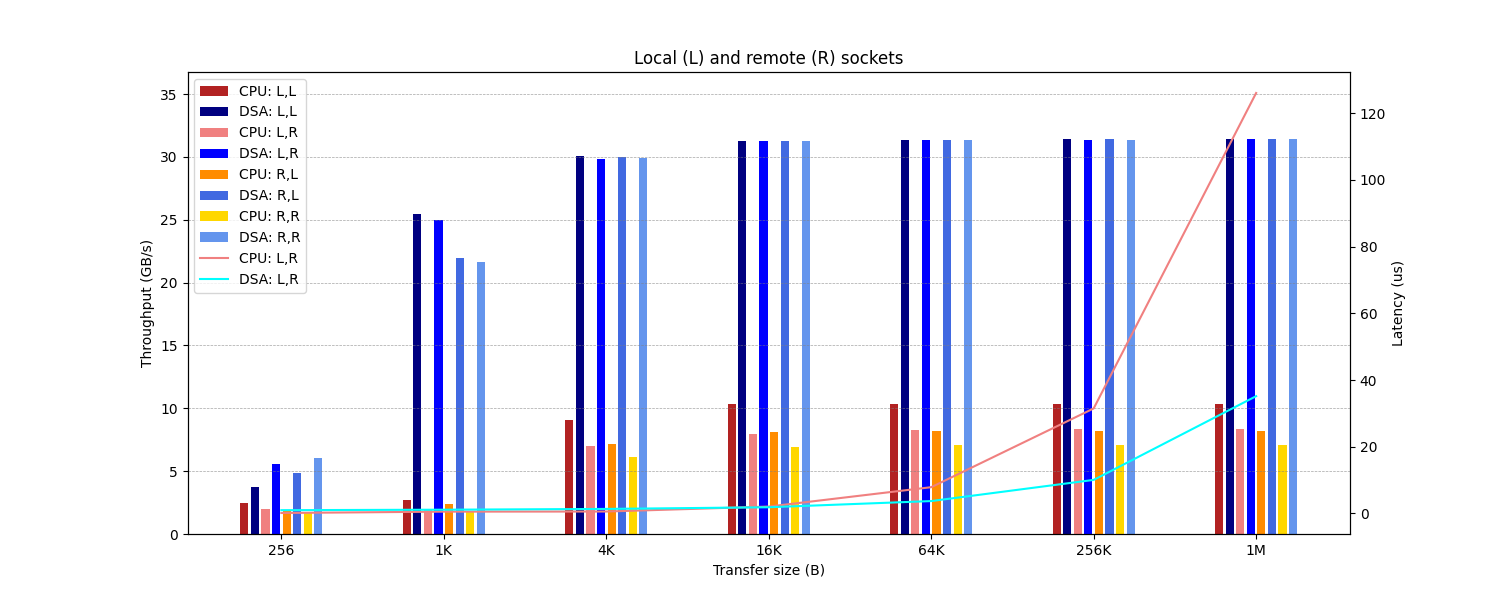
这张图展示了不同 socket 之间传输的情况,数据与论文原图也比较接近。同理,也是在 1K 条件下,表现比论文图更好。
Figure 7:Performance impact of the number of PEs on Memory Copy with varying transfer sizes (TS) and batch sizes (BS) using one WQ
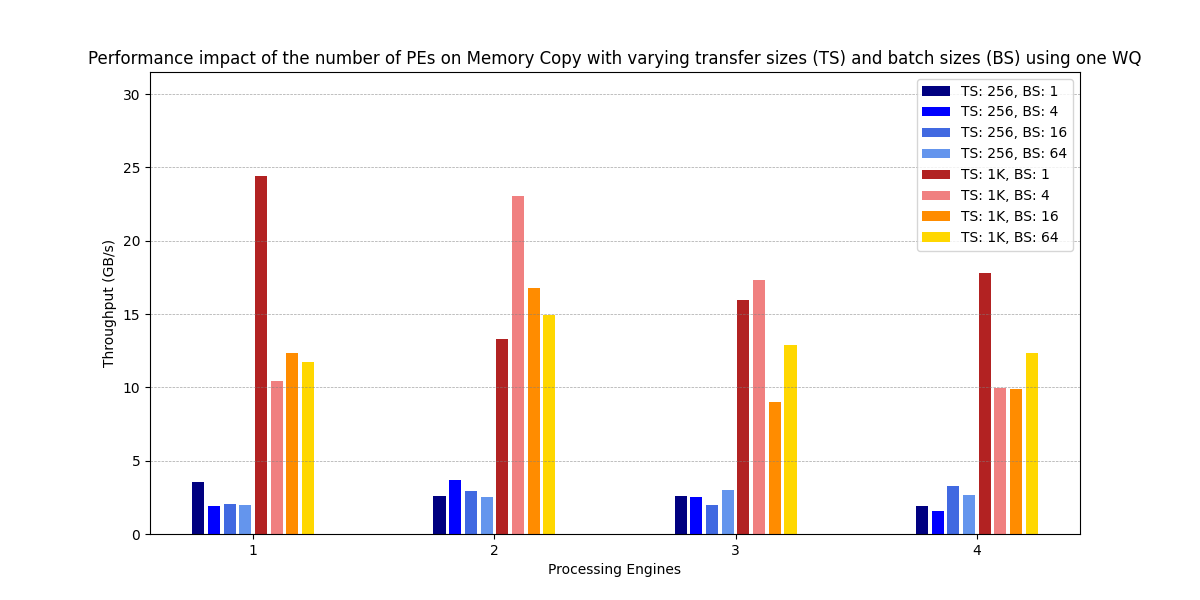
这张图的数据与原图差距也有点大,很奇怪,PE 越多,反而表现越差,不知道为什么。这张图的数据效果没有原图好。
剩下的图,有些测试比较麻烦,暂时就没有测了。关于更多测试参数和测试方法,见下文脚本代码。
DSA 测试脚本
下面是笔者写的 DSA 测试脚本和 Python Matplotlib 绘图脚本。一键运行可以自动配置 DSA,一次性测完所有数据,并一次性画完以上介绍的所有 Figure。当然也可以注释掉部分代码,只测其中部分图。
测试结果会保存在 results/${VERSION} 文件夹里面,
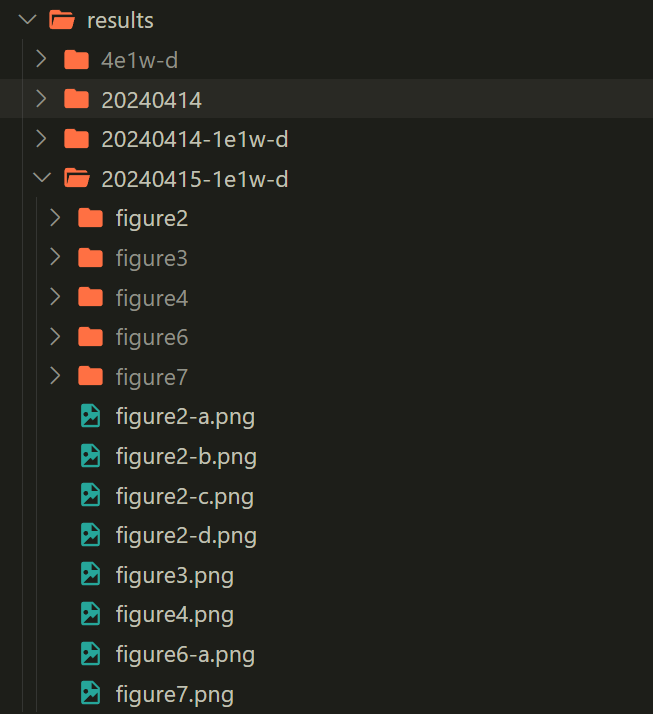
Shell 测试脚本
#!/bin/bash
# Author: LRL
set -e
VERSION="20240414-1e1w-d"
WQs=1
WQ_MODE="d" # d for dedicated, s for shared
WQ_SIZE_DEFAULT=128
ENGINES=1
DSA_ID=0
DSA_CONF="dsa${DSA_ID}-${ENGINES}e${WQs}w-${WQ_MODE}"
# timestamp=$(date +"%Y%m%d%H%M")
LOG_DIR_PREFIX="results/${VERSION}"
[[ ! -d ${LOG_DIR_PREFIX} ]] && mkdir -p ${LOG_DIR_PREFIX}
readonly LOG_DIR_PREFIX DSA_CONF DSA_ID ENGINES WQ_MODE WQs VERSION
function setup_dsa() {
local wq_size=$1
if [[ -z ${wq_size} ]]; then
local wq_size=${WQ_SIZE_DEFAULT}
local conf="${DSA_CONF}.conf"
else
local conf="${DSA_CONF}-wqsz${wq_size}.conf"
fi
echo -e "\n==> Setting DSA <==\n"
./scripts/setup_dsa.sh -d dsa${DSA_ID} -w ${WQs} -m ${WQ_MODE} -e ${ENGINES} -s "${wq_size}"
accel-config list | tee "${LOG_DIR}/${conf}"
}
function func_cache_flush() {
echo 3 > /proc/sys/vm/drop_caches
# free -h
sync
# free -h
}
function set_args() {
if [[ -z ${transfer_size} || -z ${iterations} || -z ${buffer_count} || -z ${mode} || ("${mode}" != "cpu" && -z ${batch_size})]]; then
echo -e "\nERROR: some args are empty\n"
exit 1
fi
args="-s${transfer_size} -i${iterations} -n${buffer_count}"
# set mode
if [[ "${mode}" == "async" ]]; then
args+=" -x 0x000100"
elif [[ "${mode}" == "cpu" ]]; then
args+=" -m"
fi
# set batch size
if [[ "${mode}" != "cpu" && -n ${batch_size} ]]; then
args+=" -b${batch_size}"
fi
# set NUMA node
if [[ -n ${lr} ]]; then
[[ ${lr} == "L,L" ]] && args+=" -S${LOCAL_NODE},${LOCAL_NODE}"
[[ ${lr} == "L,R" ]] && args+=" -S${LOCAL_NODE},${REMOTE_NODE}"
[[ ${lr} == "R,L" ]] && args+=" -S${REMOTE_NODE},${LOCAL_NODE}"
[[ ${lr} == "R,R" ]] && args+=" -S${REMOTE_NODE},${REMOTE_NODE}"
fi
[[ -n ${other_args} ]] && args+=" ${other_args}"
}
# remember to set $filename
function run_test() {
if [[ -z ${filename} ]]; then
echo -e "\nERROR: filename is empty\n"
exit 1
fi
func_cache_flush
set_args
PREFIX_COMMAND=""
[[ -n ${LOCAL_NODE} ]] && PREFIX_COMMAND="numactl -N ${LOCAL_NODE}"
local command
if [[ "${mode}" != "cpu" ]]; then
# shellcheck disable=SC2086
DSA_PERF_MICROS_LOG_LEVEL=info ${PREFIX_COMMAND} ./src/dsa_perf_micros ${args} 2>&1 | tee ${LOG_DIR}/"${filename}"
command="DSA_PERF_MICROS_LOG_LEVEL=info ${PREFIX_COMMAND} ./src/dsa_perf_micros ${args} 2>&1 | tee ${LOG_DIR}/${filename}"
else
# shellcheck disable=SC2086
${PREFIX_COMMAND} ./src/dsa_perf_micros ${args} 2>&1 | tee ${LOG_DIR}/"${filename}"
command="${PREFIX_COMMAND} ./src/dsa_perf_micros ${args} 2>&1 | tee ${LOG_DIR}/${filename}"
fi
echo "${command}" | tee -a ${LOG_DIR}/"${filename}"
unset filename
}
function figure2() {
# DSA_PERF_MICROS_LOG_LEVEL=info ./src/dsa_perf_micros -s256 -i1000 -c -f -w0 -zF,F -o3 2>&1 | tee ./results/4e1w-d-sync-256.log
# Figure 2
LOG_DIR="${LOG_DIR_PREFIX}/figure2"
[[ ! -d ${LOG_DIR} ]] && mkdir -p ${LOG_DIR}
MODE="sync async cpu"
TRANSFER_SIZE="256 1K 4K 16K 64K 256K 1M"
batch_size=1
buffer_count=${WQ_SIZE_DEFAULT}
other_args="-c -w0 -zF,F -o3"
setup_dsa ""
for mode in ${MODE}; do
if [[ ${mode} == "cpu" ]]; then
iterations=25 # cpu test is too slow
else
iterations=1000
fi
for transfer_size in ${TRANSFER_SIZE}; do
filename="${mode}-${transfer_size}.log"
run_test
done
done
}
function figure3() {
# Figure 3
LOG_DIR="${LOG_DIR_PREFIX}/figure3"
[[ ! -d ${LOG_DIR} ]] && mkdir -p ${LOG_DIR}
MODE="sync async"
TRANSFER_SIZE="256 1K 4K 16K 64K 256K 1M"
BATCH_SIZE="1 4 16 64"
buffer_count=${WQ_SIZE_DEFAULT}
iterations=1000
other_args="-c -w0 -zF,F -o3"
# Batch size 64 requires mannual config, config file should exist !!!
local res
res=$(accel-config list)
if [[ ${#res} -gt 3 ]]; then
accel-config disable-device dsa${DSA_ID}
fi
accel-config load-config -c ./${DSA_CONF}.conf -e
for batch_size in ${BATCH_SIZE}; do
for mode in ${MODE}; do
for transfer_size in ${TRANSFER_SIZE}; do
filename="${mode}-${batch_size}-${transfer_size}.log"
run_test
done
done
done
}
function figure4() {
# Figure 4
LOG_DIR="${LOG_DIR_PREFIX}/figure4"
[[ ! -d ${LOG_DIR} ]] && mkdir -p ${LOG_DIR}
WQ_SIZE="1 2 4 8 16 32 64 128"
TRANSFER_SIZE="256 1K 4K 16K 64K 256K 1M"
mode="async"
batch_size=1
iterations=1000
other_args="-c -w0 -zF,F -o3"
for wq_size in ${WQ_SIZE}; do
setup_dsa "${wq_size}"
buffer_count=${wq_size}
for transfer_size in ${TRANSFER_SIZE}; do
filename="${wq_size}-${transfer_size}.log"
run_test
done
done
}
function figure6() {
# Figure 6
LOG_DIR="${LOG_DIR_PREFIX}/figure6"
[[ ! -d ${LOG_DIR} ]] && mkdir -p ${LOG_DIR}
LR="L,L L,R R,L R,R"
MODE="cpu sync"
TRANSFER_SIZE="256 1K 4K 16K 64K 256K 1M"
LOCAL_NODE=0
REMOTE_NODE=1
batch_size=1
buffer_count=${WQ_SIZE_DEFAULT}
other_args="-c -w0 -zF,F -o3"
setup_dsa ""
for lr in ${LR}; do
for mode in ${MODE}; do
if [[ ${mode} == "cpu" ]]; then
iterations=25 # cpu test is too slow
else
iterations=1000
fi
for transfer_size in ${TRANSFER_SIZE}; do
filename="${mode}-${lr}-${transfer_size}.log"
run_test
if [[ ${lr} == "L,R" ]]; then
filename="${mode}-${lr}-${transfer_size}-latency.log"
other_args_bak=${other_args}
other_args="${other_args} -q1"
run_test
other_args=${other_args_bak}
fi
done
done
done
unset lr LR LOCAL_NODE REMOTE_NODE
}
function figure7() {
# Figure 7
LOG_DIR="${LOG_DIR_PREFIX}/figure7"
[[ ! -d ${LOG_DIR} ]] && mkdir -p ${LOG_DIR}
local _ENGINES="1 2 3 4"
TRANSFER_SIZE="256 1K"
BATCH_SIZE="1 4 16 64"
mode="sync"
buffer_count=${WQ_SIZE_DEFAULT}
iterations=1000
other_args="-c -w0 -zF,F -o3"
for engines in ${_ENGINES}; do
# Batch size 64 requires mannual config, config file should exist !!!
local res
res=$(accel-config list)
if [[ ${#res} -gt 3 ]]; then
accel-config disable-device dsa${DSA_ID}
fi
accel-config load-config -c ./"${DSA_CONF}-${engines}.conf" -e
for transfer_size in ${TRANSFER_SIZE}; do
for batch_size in ${BATCH_SIZE}; do
filename="${transfer_size}-${batch_size}-${engines}.log"
run_test
done
done
done
}
function main() {
figure2
figure3
figure4
figure6
figure7
}
main "$@"
Python 绘图脚本
# Author: LRL
import matplotlib.pyplot as plt
from matplotlib.axes import Axes
import re
def is_number(num):
try:
float(num)
return True
except ValueError:
return False
def read(filename: str) -> list[float]:
ret = []
with open(f"{LOG_DIR}/{filename}", mode='r') as f:
data = f.readlines()
for s in data:
t = re.split(' |,', s)
if t[0] != "GB":
continue
# ret.extend([t[4], t[6], t[9]])
for x in t:
if is_number(x):
ret.append(x)
if len(ret) == 0:
print(filename)
ret = list(map(float, ret))
return ret
def draw_yticks_line():
# 获取y轴的刻度位置
yticks = plt.yticks()[0]
# 为每个y轴的刻度绘制水平虚线
for tick in yticks:
plt.axhline(y=tick, color='gray', linestyle='--', linewidth=0.5, alpha=0.7)
def draw_figure2():
TRANSFER_SIZE = "256 1K 4K 16K 64K 256K 1M".split()
MODE = "sync async cpu".split()
global LOG_DIR
LOG_DIR = f"{LOG_DIR_PREFIX}/figure2"
data: dict[str, list[float]] = {}
for mode in MODE:
data[mode] = []
for transfer_size in TRANSFER_SIZE:
GB_ps = read(f"{mode}-{transfer_size}.log")[0]
data[mode].append(GB_ps)
# print(data)
n = len(TRANSFER_SIZE)
bar_width = 0.15
r1 = [x for x in range(n)]
r2 = [x + bar_width for x in r1]
plt.figure(figsize=(8, 4.8))
plt.bar(r1, data['cpu'], width=bar_width, color='royalblue', label='cpu')
plt.bar(r2, data['sync'], width=bar_width, color='darkorange', label='sync')
plt.xticks([x - 0.5 * bar_width + 2 * bar_width / 2 for x in r1], TRANSFER_SIZE)
draw_yticks_line()
plt.xlabel('Transfer size (B)')
plt.ylabel('Throughput (GB/s)')
plt.title('Synchronous offloading')
plt.legend()
# plt.show()
plt.savefig(f"{LOG_DIR_PREFIX}/figure2-a.png", format='png')
plt.clf()
plt.bar(r1, data['cpu'], width=bar_width, color='royalblue', label='cpu')
plt.bar(r2, data['async'], width=bar_width, color='darkorange', label='async')
draw_yticks_line()
plt.xticks([x - 0.5 * bar_width + 2 * bar_width / 2 for x in r1], TRANSFER_SIZE)
plt.xlabel('Transfer size (B)')
plt.ylabel('Throughput (GB/s)')
plt.title('Asynchronous offloading')
plt.legend()
# plt.show()
plt.savefig(f"{LOG_DIR_PREFIX}/figure2-b.png", format='png')
plt.clf()
sync_improve = [(y - x) / x for x, y in zip(data['cpu'], data['sync'])]
plt.bar(r1, sync_improve, width=bar_width, color='slateblue')
draw_yticks_line()
plt.xticks([x for x in r1], TRANSFER_SIZE)
plt.xlabel('Transfer size (B)')
plt.ylabel('Throughput improvement')
plt.title('Synchronous offloading')
# plt.show()
plt.savefig(f"{LOG_DIR_PREFIX}/figure2-c.png", format='png')
plt.clf()
async_improve = [(y - x) / x for x, y in zip(data['cpu'], data['async'])]
plt.bar(r1, sync_improve, width=bar_width, color='slateblue')
draw_yticks_line()
plt.xticks([x for x in r1], TRANSFER_SIZE)
plt.xlabel('Transfer size (B)')
plt.ylabel('Throughput improvement')
plt.title('Asynchronous offloading')
# plt.show()
plt.savefig(f"{LOG_DIR_PREFIX}/figure2-d.png", format='png')
def draw_figure3():
TRANSFER_SIZE = "256 1K 4K 16K 64K 256K 1M".split()
MODE = "sync async".split()
BATCH_SIZE="1 4 16 64".split()
global LOG_DIR
LOG_DIR = f"{LOG_DIR_PREFIX}/figure3"
data: dict[str, dict[str, list[float]]] = {}
for mode in MODE:
data[mode] = {}
for batch_size in BATCH_SIZE:
data[mode][batch_size] = []
for transfer_size in TRANSFER_SIZE:
GB_ps = read(f"{mode}-{batch_size}-{transfer_size}.log")[0]
data[mode][batch_size].append(GB_ps)
# print(data)
n = len(TRANSFER_SIZE)
bar_width, gap = 0.05, 0.015
width = bar_width + gap
r = [x for x in range(n)]
p = 0
plt.figure(figsize=(12, 6))
COLOR="navy blue royalblue cornflowerblue firebrick lightcoral darkorange gold".split()
for mode in MODE:
for batch_size in BATCH_SIZE:
rx = [x + p * width for x in r]
label_name = f"{mode}".upper()[0] + f"{mode}"[1:] + f", BS: {batch_size}"
plt.bar(rx, data[mode][batch_size], width=bar_width, color=COLOR[p], label=label_name)
p += 1
plt.xticks([x - 0.5 * width + len(MODE) * len(BATCH_SIZE) * width / 2 for x in r], TRANSFER_SIZE)
draw_yticks_line()
plt.xlabel('Transfer size (B)')
plt.ylabel('Throughput (GB/s)')
plt.title('Throughput of DSA\'s Memory Copy operation on Sync or Async offloading with varying transfer sizes and batch sizes (BS)')
plt.legend()
plt.savefig(f"{LOG_DIR_PREFIX}/figure3.png", format='png')
def draw_figure4():
WQ_SIZE="1 2 4 8 16 32 64 128".split()
TRANSFER_SIZE="256 1K 4K 16K 64K 256K 1M".split()
global LOG_DIR
LOG_DIR = f"{LOG_DIR_PREFIX}/figure4"
data: dict[str, list[float]] = {}
for wq_size in WQ_SIZE:
data[wq_size] = []
for transfer_size in TRANSFER_SIZE:
GB_ps = read(f"{wq_size}-{transfer_size}.log")[0]
data[wq_size].append(GB_ps)
# print(data)
n = len(TRANSFER_SIZE)
bar_width, gap = 0.05, 0.015
width = bar_width + gap
r = [x for x in range(n)]
p = 0
plt.figure(figsize=(12, 6))
COLOR="black midnightblue navy darkblue royalblue cornflowerblue skyblue lightskyblue".split()
for wq_size in WQ_SIZE:
rx = [x + p * width for x in r]
plt.bar(rx, data[wq_size], width=bar_width, color=COLOR[p], label=f"WQS: {wq_size}")
p += 1
plt.xticks([x - 0.5 * width + len(WQ_SIZE) * width / 2 for x in r], TRANSFER_SIZE)
draw_yticks_line()
plt.xlabel('Transfer size (B)')
plt.ylabel('Throughput (GB/s)')
plt.title('Throughput of DSA\'s asynchronous Memory Copy operation with different WQ sizes (WQS)')
plt.legend()
plt.savefig(f"{LOG_DIR_PREFIX}/figure4.png", format='png')
def draw_figure6():
LR="L,L L,R R,L R,R".split()
MODE="cpu sync".split()
TRANSFER_SIZE="256 1K 4K 16K 64K 256K 1M".split()
global LOG_DIR
LOG_DIR = f"{LOG_DIR_PREFIX}/figure6"
data: dict[str, dict[str, dict[str, list[float]]]] = {}
for lr in LR:
data[lr] = {}
for mode in MODE:
data[lr][mode] = {}
data[lr][mode]['GB'], data[lr][mode]['latency'] = [], []
for transfer_size in TRANSFER_SIZE:
GB_ps = read(f"{mode}-{lr}-{transfer_size}.log")[0]
data[lr][mode]['GB'].append(GB_ps)
if lr == "L,R":
latency = read(f"{mode}-{lr}-{transfer_size}-latency.log")[2]
data[lr][mode]['latency'].append(latency / 1000.0)
# print(data['L,R']['cpu']['latency'], data['L,R']['sync']['latency'])
n = len(TRANSFER_SIZE)
bar_width, gap = 0.05, 0.015
width = bar_width + gap
r = [x for x in range(n)]
p = 0
fig, ax1 = plt.subplots(figsize=(15, 6))
ax1: Axes = ax1
COLOR="firebrick navy lightcoral blue darkorange royalblue gold cornflowerblue".split()
for lr in LR:
for mode in MODE:
rx = [x + p * width for x in r]
label_name = "CPU" if mode == "cpu" else "DSA"
label_name = f"{label_name}: {lr}"
ax1.bar(rx, data[lr][mode]['GB'], width=bar_width, color=COLOR[p], label=label_name)
p += 1
ax1.set_xticks([x - 0.5 * width + len(LR) * len(MODE) * width / 2 for x in r], TRANSFER_SIZE)
ax1.set_xlabel('Transfer size (B)')
ax1.set_ylabel('Throughput (GB/s)')
ax1.set_title('Local (L) and remote (R) sockets')
draw_yticks_line()
ax2: Axes = ax1.twinx()
COLOR="lightcoral cyan".split()
p = 0
for mode in MODE:
lr = "L,R"
label_name = "CPU" if mode == "cpu" else "DSA"
label_name = f"{label_name}: {lr}"
ax2.plot([x - 0.5 * width + len(LR) * len(MODE) * width / 2 for x in r], data[lr][mode]['latency'], color=COLOR[p], label=label_name)
p += 1
ax2.set_ylabel('Latency (us)')
lines, labels = ax1.get_legend_handles_labels()
lines2, labels2 = ax2.get_legend_handles_labels()
ax2.legend(lines + lines2, labels + labels2)
plt.savefig(f"{LOG_DIR_PREFIX}/figure6-a.png", format='png')
def draw_figure7():
ENGINES="1 2 3 4".split()
TRANSFER_SIZE="256 1K".split()
BATCH_SIZE="1 4 16 64".split()
global LOG_DIR
LOG_DIR = f"{LOG_DIR_PREFIX}/figure7"
data: dict[str, dict[str, list[float]]] = {}
for transfer_size in TRANSFER_SIZE:
data[transfer_size] = {}
for batch_size in BATCH_SIZE:
data[transfer_size][batch_size] = []
for engines in ENGINES:
GB_ps = read(f"{transfer_size}-{batch_size}-{engines}.log")[0]
data[transfer_size][batch_size].append(GB_ps)
# print(data)
n = len(ENGINES)
bar_width, gap = 0.05, 0.015
width = bar_width + gap
r = [x for x in range(n)]
p = 0
plt.figure(figsize=(12, 6))
COLOR="navy blue royalblue cornflowerblue firebrick lightcoral darkorange gold".split()
for transfer_size in TRANSFER_SIZE:
for batch_size in BATCH_SIZE:
rx = [x + p * width for x in r]
label_name = f"TS: {transfer_size}, BS: {batch_size}"
plt.bar(rx, data[transfer_size][batch_size], width=bar_width, color=COLOR[p], label=label_name)
p += 1
plt.xticks([x - 0.5 * width + len(TRANSFER_SIZE) * len(BATCH_SIZE) * width / 2 for x in r], ENGINES)
draw_yticks_line()
plt.xlabel('Processing Engines')
plt.ylabel('Throughput (GB/s)')
plt.title('Performance impact of the number of PEs on Memory Copy with varying transfer sizes (TS) and batch sizes (BS) using one WQ')
plt.legend()
plt.savefig(f"{LOG_DIR_PREFIX}/figure7.png", format='png')
def main():
draw_figure2()
draw_figure3()
draw_figure4()
draw_figure6()
draw_figure7()
LOG_DIR_PREFIX = "results/20240414-1e1w-d"
LOG_DIR = ""
main()
References
Intel® Data Streaming Accelerator User Guide
Enabling Intel Data Streaming Accelerator on Lenovo ThinkSystem Servers
Matplotlib 3.8.4 documentation

%%%